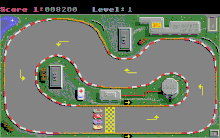Racing game


A racing game is a genre of computer games in which the aim is to drive a predetermined route (often a circuit ) with a vehicle or other means of transportation. The winner is usually the player who reaches the goal first or who has completed the required number of laps first.
variants
There are roughly two different variants of racing games: In a so-called fun racer , the priority is primarily on the player's fun, realism and credibility tend to take a back seat. For example, extreme speeds, unrealistic driving behavior, weapons or items are often encountered here. They are often modeled on arcade games and only require a short period of time to get used to. Examples are F-Zero , Mario Kart , TrackMania or Wipeout .
In racing simulations , on the other hand, an attempt is made to simulate a world that is as realistic as possible for the player. The driving behavior and the technical data of the vehicles are imitated by real models, and the routes in the game are often modeled on original, real-world routes. These games often take a long time to get used to, although it is common nowadays to be able to activate driving aids. Examples of racing simulations are the parts of the Grand Prix series , Grand Prix Legends , GTR , Gran Turismo or Live for Speed .
Racing games can also be divided according to the type of display (bird's eye view, 2D view, 3D view) and the type of vehicle. As with other genres, there is some overlap with related and unrelated genres. In addition to racing simulations, there are also, for example, traffic or driving simulations and games with shoot-'em-up components, so-called "vehicular combat", in which opponents are shot at while driving. There are also racing games in mazes , in role-playing games or as (water) sports games. Some simple games, in which you e.g. B. only has to evade, are usually referred to as games of skill.
The perspective can in many 3D games are switched as complete first-person , first-person view with partial view of the own vehicle or cockpits, prosecutors perspective view to the rear, Helicopter Point and some more.
Means of transportation
In racing games, mostly racing or rally cars are to be controlled, other vehicles such as karts or motorcycles are also common. Trucks, bicycles, ships, animals (e.g. Sonic ) or even futuristic vehicles that are usually flown quickly are less common .
Multiplayer racing games
With game consoles, a vertical split screen is widespread when games are played at the same time . In amusement arcades, there are usually devices with several seats and monitors, often two or four.
1975 appeared with Indy 800 from Kee Games (Atari) a game for eight players at the same time. It was also the first video game with full color graphics.
History of racing games
One of the first video racing games was the Atari - Arcade game Gran Trak 10 from a bird's eye view in 1974 . This game principle was also implemented on consoles and home computers in the 1970s and 1980s. Before that there were electro-mechanical slot machines. In the early 1970s, Evan & Sutherland produced an early 3D driving simulation for Volkswagen , still in black and white and with vector graphics (see PDF web links). However, the first commercial 3D racing simulation in video games is considered to be Night Driver (Atari, 1976). Also in 1976 Exidy released Death Race, one of the first controversial video games.
The first modern 3D racing game with color graphics is considered to be Pole Position (Namco, 1982), which, due to its sequence, is more of a racing simulation. In 1986, Out Run introduced force feedback . Other well-known games of the 1980s included Rally-X (Namco, 1980, Maze), Spy Hunter (Bally Midway, 1983, Vehicular Combat), Chase HQ (Taito, 1988, Action / Espionage) and the Test Drive series (Accolade, 1987, driving simulation). The graphics, sound and other elements were enhanced by the appearance of 16-bit consoles and home computers in the late 1980s, e.g. B. the Amiga constantly improved.
In the 1990s, realistic racing simulations continued to appear, but also with Super Mario Kart (Nintendo, 1992) the first fun racer. Other well-known games, mostly series of the decade, were Virtua Racing (Sega, 1992, Formula 1), Ridge Racer (Namco, 1993), Need for Speed (Electronic Arts, 1994), Bleifuss (Virgin, 1995), Gran Turismo (Polyphony Digital, 1997, simulation), Colin McRae Rally (Codemasters, 1998) and Autobahn Raser (Davilex, 1998).
Many successful series continued through the 2000s. Well-known games were Midnight Club and the Grand Theft Auto series. From the end of the 1990s, futuristic racing games, truck and off-road simulations, including free games, became increasingly popular .
From the end of the 2000s, browser games also became established ; Pyongyang Racer is an exceptional example .
See also
- Category: racing game
- List of computer games by genre # racing games
- Racing simulation
- Driving simulator
Web links
- Racing game at MobyGames (English)
- A History of Racing Video Games ( Memento from October 16, 2009 in the Internet Archive )
- History of racing games (various PDF files, mostly electro-mechanical)
- Mechanical and electromechanical racing games 1940s-1970s, some with audio and video files

